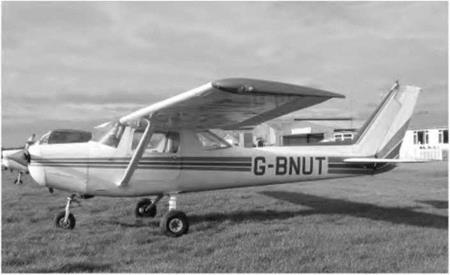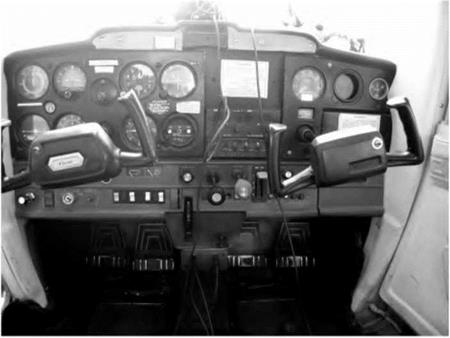Dynamic stability
In this chapter we have dealt mainly with what is known as static stability. There are other forms of instability that the designer (and the pilot) has to cope with. These take the form of oscillations or deviations from the desired flight path that vary with time, and are known as dynamic instabilities. They can be a nuisance, nauseating or downright dangerous if left unchecked. An example is the spiral instability referred to earlier in this chapter.
A full description of dynamic stability is beyond the scope of this book, but the reader should be aware that the problems of stability and control are far more complex than the simple outline given here.
Can you answer these?
Questions on stability and control –
1. What would be the characteristics of an aircraft with extreme directional stability and little lateral stability?
2. What would be the characteristics of an aircraft with extreme lateral stability and little directional stability?
3. What is the object of balancing controls?
4. Distinguish between ‘mass’ balance and ‘aerodynamic’ balance.
5. Explain the difficulty of obtaining satisfactory lateral control at large angles of attack.
6. Describe some of the methods which have been tried with a view to overcoming this difficulty.
7. Explain why spoilers are sometimes used at low speeds, and sometimes at high speeds, as an aid to lateral control.
For solutions see Appendix 5.
In the preceding chapters I have tried to explain the principles on which the flight of an aeroplane depends. However, flying an aeroplane is a different thing altogether and in this chapter we will explore what it is actually like to fly a light, low-speed aircraft of the sort that most pilots use when they start their training. During the flight we will use the knowledge we have gained previously to explain what is happening.
The aircraft we will fly is shown in Fig. 10A. It is a simple aircraft with fixed undercarriage and a fixed pitch propeller driven by a piston engine. Let us have a quick look in the cockpit to see the instruments and controls (Fig. 10B, overleaf). First we notice the main flying instruments – an air-speed indicator (ASI, calibrated in knots), an altimeter (calibrated in ft), a rate of climb
|
|
Fig 10A Cessna 152, the aircraft for our flight
indicator (ft/min), and a turn and slip indicator (Fig. 8.6). Then we have an artificial horizon and a direction indicator (DI). Finally, tucked away at the top of the windshield, we have a small magnetic compass.
Next we come to the engine and fuel instruments; the tachometer, which measures the engine speed, is situated on the right hand side of the cockpit, then comes the ammeter (which shows if our electrical generator is working properly) and next to this is a suction gauge. The suction gauge is needed because the artificial horizon and the DI are gyroscopic instruments, which derive their power from engine-supplied suction. If the suction drops below a certain level, these instruments will become unreliable as the gyroscopes slow down and we need warning if this is likely to happen! Under the cluster of main flight instruments we find the fuel gauges (one for each wing tank) and indicators for engine temperature and oil pressure.
The flying controls are quite simple. In front of us is the main yoke. We push this forward to lower the elevators and nose of the aircraft, or pull to raise the nose. We turn the ‘wheel’ to operate the ailerons and bank the aircraft to left or right. At our feet are the pedals, which are used to operate the rudder, and above the pedals the toe-operated differential brakes are situated. On a quadrant, in front of us, there is the flap lever and position indicator. On this aircraft the flaps are electrically operated and so they will not work until the electrical supply is turned on.
|
|
Fig 10B The cockpit
The engine controls are quite simple. A push-pull throttle control is provided on the dashboard – push forward to increase engine revs. Apart from this there is a mixture control to compensate for the reduced air density as we climb and a carburettor heat control which we use, particularly at reduced engine speeds, to prevent the carburettor icing up – possibly with disastrous results! As we will only be flying at or below 3000 ft, we will leave the mixture at rich until we eventually want to stop the engine.
To complete the story we need to take a quick look at the navigational equipment. On this aircraft we have a communications radio, a navigational radio (which we shall not use, as we are flying in good visibility and not far from the airfield) and a transponder to allow Air Traffic Control to track our position. Under the fuel gauges and engine instruments is the key-operated switch for the magnetos and engine starter (rather like the ignition switch on a car), together with the light switches and pitot heater switch. Tike the carburettor heater, this prevents the formation of ice but this time on the pitot-static tube, which is vital if we are going to know our correct airspeed. There is also a master switch, which isolates all the electrical systems apart from the magnetos. These provide the spark at the spark plugs and keep the engine running. If there is an electrical fault and we have to switch off the master, at least the engine will not stop!
So far we have spent a long time and the aircraft has not even moved yet. Well, that’s flying! If something goes wrong in a car you can always pull off the road to sort it out. With an aeroplane we have to make sure everything is OK before we start off.













